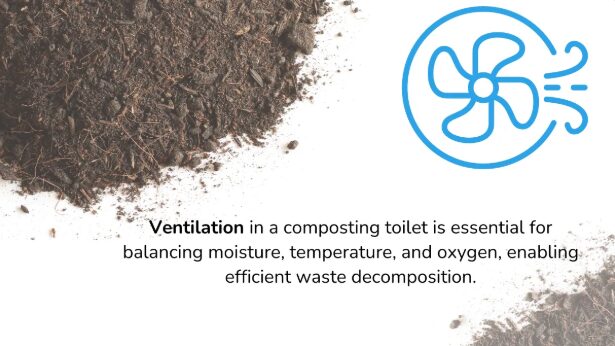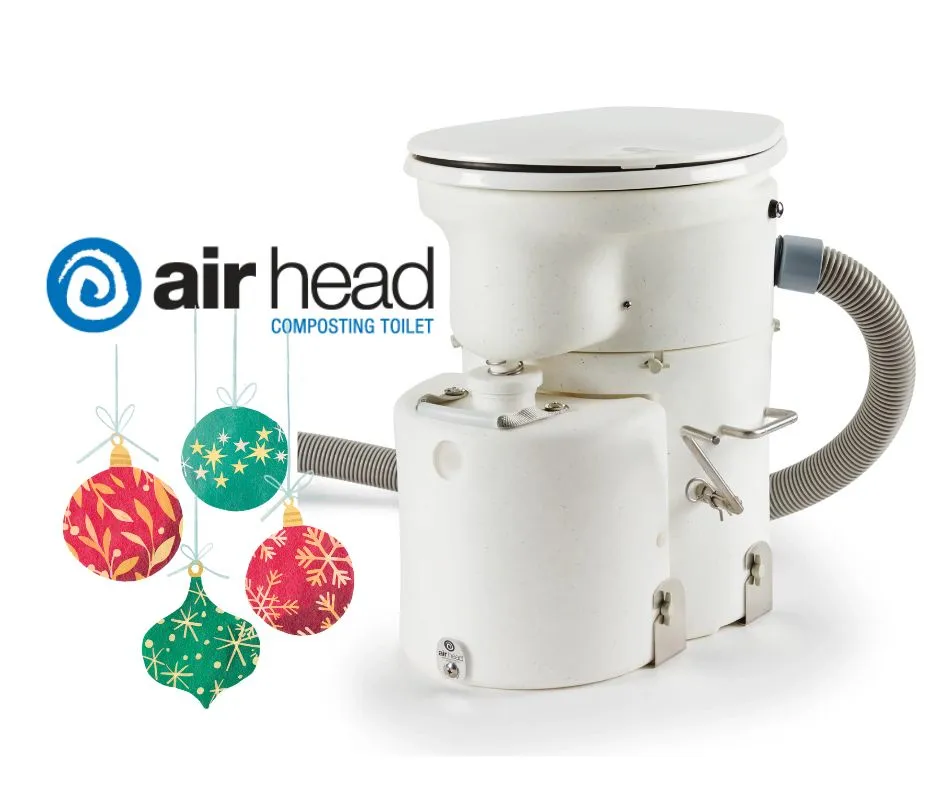
When it comes to managing waste in an RV or boat, composting toilets have gained significant popularity. They offer a sustainable and simple alternative to traditional waste disposal systems, using natural processes to break down human waste into safe, usable compost. Among the many components that ensure a composting toilet functions effectively, ventilation filters air is one of the most critical elements. Without proper ventilation, even the most advanced composting toilet could become ineffective, smelly, and inefficient.
In this article, we’ll explore why ventilation is so important for a composting toilet, the role of a fan, and how the Air Head Composting Toilet takes ventilation to the next level with its unique design.
The Role of Ventilation in Composting Toilets
1. Ventilation Ensures Odor Control
One of the most common concerns people have when considering a composting toilet is the potential for unpleasant odors. Unlike traditional toilets that flush waste away with water, ventilation filters air, composting toilets rely on aerobic decomposition—a process that requires oxygen to effectively break down waste without producing foul smells.
Proper ventilation filters air in a composting toilet, which is essential for maintaining a pleasant environment.
By ensuring that ventilation filters air, the composting process remains both efficient and effective, leading to better outcomes.
A well-installed fan ensures that ventilation filters air properly, which is vital for odor control and waste breakdown.
Moreover, effective ventilation filters air within the composting toilet, promoting a healthier environment.
When waste enters a composting toilet, it begins to decompose. In a well-ventilated system, oxygen is continuously supplied to the waste, allowing aerobic bacteria to thrive. These bacteria are responsible for breaking down the waste efficiently while minimizing the production of smelly byproducts like ammonia and hydrogen sulfide.
This balance is maintained because ventilation filters air, promoting aerobic decomposition.
However, without proper ventilation, oxygen supply becomes limited, and anaerobic bacteria (which do not require oxygen) can take over. Anaerobic decomposition is slower and produces unpleasant odors as a byproduct. This is why having a reliable ventilation system is crucial. It not only prevents the build-up of bad smells but also ensures that the composting process is effective and efficient.
Effective ventilation filters air and helps in the breakdown of waste, ensuring a successful composting process.
2. Ventilation is Crucial for the Composting Process
Overall, ventilation filters air and supports the entire composting system, increasing its efficiency.
Composting toilets, by design, create an environment where waste can decompose naturally over time. For composting to occur, several factors need to be in balance: moisture, temperature, oxygen, and microbial activity. Ventilation plays a key role in maintaining this balance.
Furthermore, ensuring that ventilation filters air efficiently will greatly minimize odor issues.
Oxygen is necessary for the aerobic microbes responsible for breaking down waste into compost. A consistent flow of fresh air through the composting chamber supplies these microbes with the oxygen they need to survive and thrive. Without it, the composting process can stall, leading to partially decomposed waste, potential health hazards, and unpleasant odors.

This is because effective ventilation filters air, supporting the composting process and reducing odors.
In addition to providing oxygen, ventilation helps regulate moisture levels inside the composting toilet. Excess moisture can slow down the composting process, create anaerobic conditions, and lead to unpleasant smells. Proper ventilation helps to evaporate excess moisture, keeping the compost dry enough to decompose efficiently while still maintaining the necessary moisture level for microbial activity.
Why You Need a Fan in Your Composting Toilet
With the right setup, ventilation filters air properly, enhancing the overall performance of the system.
This superior design ensures that ventilation filters air effectively, making it a standout option.
To ensure adequate ventilation, most composting toilets, including the Air Head Composting Toilet, are equipped with a fan that actively pulls air through the system and vents it outside. Here’s why having a fan is a game-changer for composting toilets:
The fan included with your unit will maintain that ventilation filters air is consistent and effective.
1. Active Airflow for Better Odor Control
By customizing your setup correctly, ventilation filters air in a way that meets your specific needs.
While natural ventilation can help, it may not always be enough to maintain the necessary airflow, especially in confined spaces like boats, RVs, or tiny homes where composting toilets are often used. Ventilation filters air. The fan in a composting toilet ensures active ventilation by continuously drawing fresh air into the composting chamber and expelling the gases produced during decomposition outside. This active airflow significantly reduces the risk of odors escaping into the living space.

Choosing high-quality components ensures that ventilation filters air reliably over time.
2. Assisting the Composting Process
The fan doesn’t just help with odor control—it also aids in the composting process itself. By ensuring a constant supply of oxygen, the fan promotes aerobic decomposition, leading to more efficient composting. It also helps to remove excess moisture from the composting chamber, preventing the compost from becoming too wet, which could otherwise slow down decomposition and lead to unpleasant odors.
3. Essential for Closed Spaces
In closed spaces, like cabins or RVs, where natural air circulation may be limited, a fan becomes indispensable. It helps maintain a steady flow of air, ensuring that the composting toilet functions properly even when the surrounding environment doesn’t provide sufficient ventilation. This is particularly important for maintaining a comfortable and odor-free living environment.
Air Head Composting Toilet: Ventilation Done Right
The Air Head Composting Toilet is designed with effective ventilation in mind. Understanding the importance of ventilation for both odor control and efficient composting, Air Head includes a high-quality fan and vent hose with every unit. This fan, when installed correctly, ensures that your composting toilet remains odor-free and that the composting process continues smoothly.
1. Included Fan and Vent Hose
In conclusion, ensuring that ventilation filters air properly is essential for long-term performance.
With the Air Head Composting Toilet, effective ventilation filters air for an odor-free experience.
Choose an Air Head Composting Toilet for a system where ventilation filters air optimally, enhancing your next adventure.
When you purchase an Air Head Composting Toilet, you receive a fan and vent hose as part of the package. This eliminates the need to source these components separately, ensuring that you have everything you need for a proper installation. The included fan is powerful enough to maintain active ventilation, yet quiet enough to operate without causing a disturbance.

2. Customizable Venting Options
For installations where a longer run of vent hose is required—such as when installing the toilet further away from an external wall or vent—additional hose can be purchased. This flexibility allows you to customize the ventilation system to suit your specific setup, ensuring that your Air Head Composting Toilet performs optimally in any environment.
3. Durable, High-Quality Materials
The Air Head fan and vent hose are made from durable, high-quality materials that can withstand the rigors of many environments. Whether you’re using the composting toilet on a boat exposed to salty air, in a humid off-grid cabin, or in a mobile tiny home, you can trust that the ventilation system will hold up over time, providing consistent and reliable performance.
Installation Tips for Optimal Ventilation
To get the most out of your Air Head Composting Toilet’s ventilation system, proper installation is key. Here are a few tips to ensure optimal performance:
- Position the Vent Hose Carefully: The vent hose should be installed with a slight upward slope to prevent any moisture from collecting inside the hose, which could reduce airflow and lead to blockages.
- Seal Connections: Ensure that all connections between the fan, vent hose, and exterior vent are securely sealed. This prevents any odors from escaping and ensures that all the air being pulled through the system is effectively vented outside.
- Regular Maintenance: Over time, dust or debris may accumulate in the vent hose or fan, reducing their efficiency. Regularly check and clean the ventilation components to maintain optimal airflow and prevent any reduction in performance.

Conclusion
Ventilation is a crucial aspect of any composting toilet, and the importance of a well-functioning fan cannot be overstated. From odor control to ensuring the composting process is efficient, proper ventilation filters air and is key to making the most of your composting toilet. The Air Head Composting Toilet goes above and beyond in this regard, providing a complete ventilation system that’s designed to keep your space odor-free and your composting toilet functioning at its best.
Forget about planning your next trip around toilets and pump out locations, choose and Air Head Composting Toilet for your next adventure.







